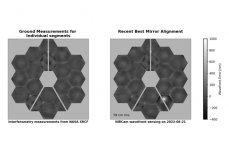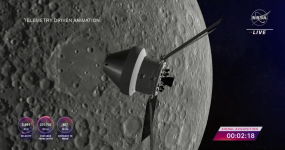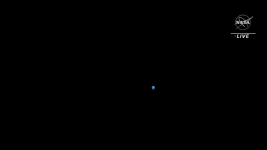Crop of a single 1 second exposure using the 2x on m42 trapezium. Note the aligned was fixed after... but there's separation on E without any processing and it looks like (with good conditions+alignment) that F would pop out too!
The image was at 0.80 arc sec/pixel! Dawes Limit on the scope being 1.10!

M42 trapezium - note the Dawes limit but i did manage to get to see some separation with a 650mm fl 105mm diameter scope. As you can see I stopped going for beauty years ago.
vs hubble+chandra etc colourised narrowband layers:

The image was at 0.80 arc sec/pixel! Dawes Limit on the scope being 1.10!
M42 trapezium - note the Dawes limit but i did manage to get to see some separation with a 650mm fl 105mm diameter scope. As you can see I stopped going for beauty years ago.
vs hubble+chandra etc colourised narrowband layers:
Last edited:
I think Dr Becky gives a decent enough explanation of the gyrations it takes to deliver the images we see.
and let’s face it, she’s hella more fun to watch than some of the other astrophysicists with whom most of us are familiar
James Webb satelite telescope hit by a small meteor damaging one of the hexagonal panels: https://www.space.com/james-webb-sp...k the James,launch modeling had accounted for.
James Webb satelite telescope hit by a small meteor damaging one of the hexagonal panels: https://www.space.com/james-webb-sp...k the James,launch modeling had accounted for.
Yup, however given they had to sort out Hubble.. I would suspect it's non-terminal. Bodes well for any human space exploration..
Reminds me of this recent image, but it's an unrelated rendition of how a black hole might look.telescope hit by a small meteor damaging one of the hexagonal panels
That's also what I read.the problem with that strike was that it WASN'T modelled for
The NASA report said the strike "exceeded prelaunch expectations of damage for a single micrometeoroid".
The damage to the C3 segment is visible in the right hand infrared image of the attachment.
Thankfully, adjustments have ensured that the entire mirror is still working within the performance limits that were hoped for.
The damage to the C3 segment is visible in the right hand infrared image of the attachment.
Thankfully, adjustments have ensured that the entire mirror is still working within the performance limits that were hoped for.
Attachments
I thought the problem with that strike was that it WASN'T modelled for and was some 2 orders of magnitude larger than expected? 1/2mv2 is a biatch in space...
Well they just have get off their lazy behinds and model it 😛 (ie it's not one they have a solution for already).
Given the size of these particles is so small with high energy and from any direction, it shows we need to develop technology to combat it.
I was looking at the Phantom Galaxy image and there is a short interview with the astronomer behind it. The article saidMore than 60% and better tools than photoshop - astro imaging stuff contains all sorts of error correcting and deconvolving tools, and operate on 96 or more bit images (eg luminance plus 3 filters, 24 bits per pixel). Photoshop's not up to it... Look at Pixinsight for example...
Schmidt reportedly used Photoshop and FITS Liberator for most of the work and said many of the concepts in her 2017 YouTube imaging tutorial will help with the more advanced software of today.
Not had time to look at the tutorial but note that FITS 'appears' to be a photoshop plugin with the clever bits in for those who like the photoshop workflow.
Check out the Artemis thread: https://www.diyaudio.com/community/threads/artemis-the-nasa-mission.392333/
So they shift the wavelengths to make the image visible. Very cool and very useful.
It reminds me of Pink Floyd's "Echoes." They recorded whale sounds and slowed the track down so they were audible. I can actually enjoy Echoes more now than back in the day. Here it is 50 years later, great version.

It reminds me of Pink Floyd's "Echoes." They recorded whale sounds and slowed the track down so they were audible. I can actually enjoy Echoes more now than back in the day. Here it is 50 years later, great version.
- Home
- Member Areas
- The Lounge
- How James Webb images are created



